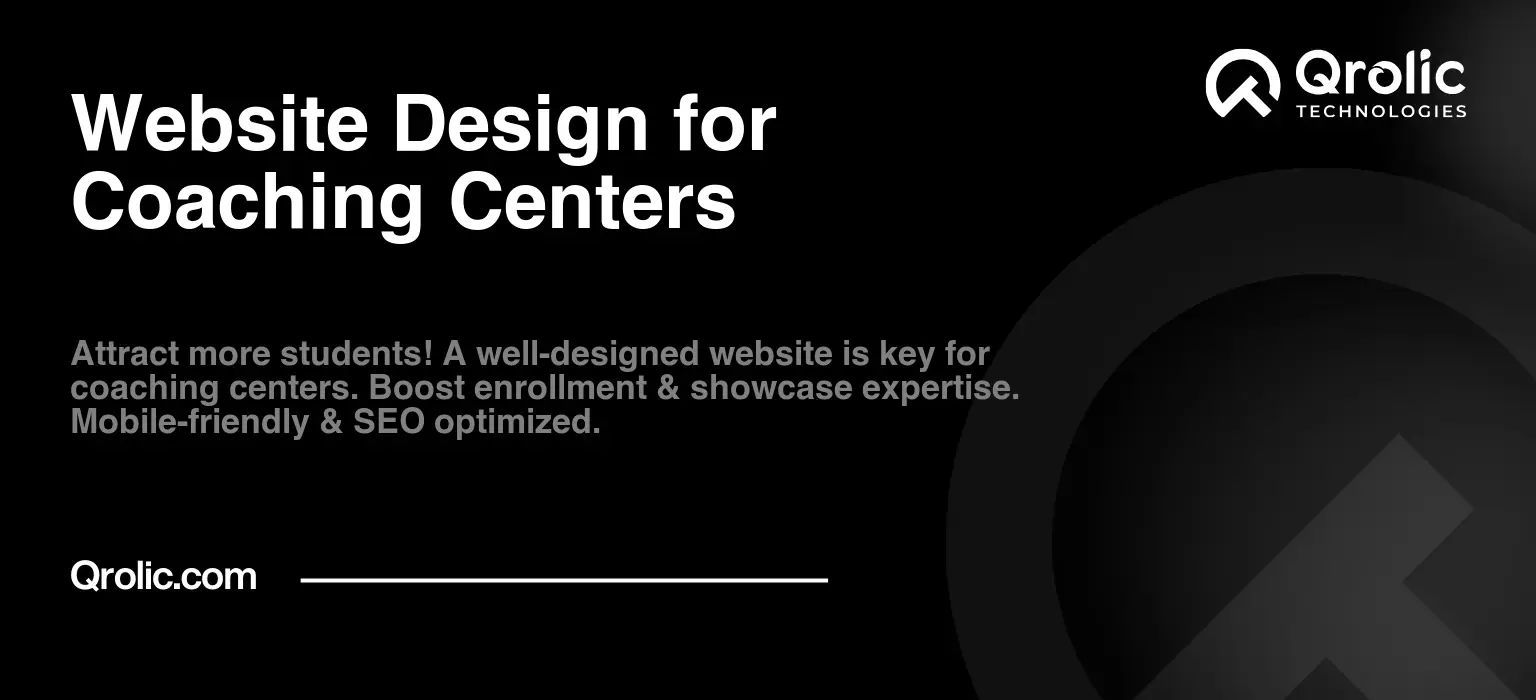In today’s digital age, a well-designed website is not just a luxury for coaching centers; it’s an absolute necessity. It’s your digital storefront, your 24/7 brochure, and the primary touchpoint for prospective students and their parents. A compelling website can transform your coaching center from a local secret to a sought-after educational hub. This comprehensive guide will explore every facet of website design for coaching centers, ensuring you create a powerful online presence that drives enrollment and elevates your brand.
Quick Summary:
- Your website is essential for attracting students.
- Clearly showcase courses, expert faculty, and success stories.
- Optimize your site for search engines (SEO) to be found.
- Ensure it’s fast, mobile-friendly, and easy to navigate.
Table of Contents
- 1. Understanding the Critical Role of Website Design for Coaching Centers
- 2. Key Elements of an Effective Coaching Center Website Design
- 2.1. Homepage Design: The First Impression
- 2.2. About Us Page: Building Trust and Credibility
- 2.3. Course Pages: Showcasing Your Offerings
- 2.4. Blog: Sharing Knowledge and Expertise
- 2.5. Contact Page: Making it Easy to Connect
- 2.6. Testimonials and Success Stories: Social Proof is Powerful
- 3. Optimizing Your Website for Search Engines (SEO)
- 3.1. Keyword Research: Finding the Right Words
- 3.2. On-Page Optimization: Making Your Website Search-Engine Friendly
- 3.3. Off-Page Optimization: Building Your Website’s Authority
- 3.4. Technical SEO: Ensuring a Smooth User Experience
- 4. Website Design Best Practices for Coaching Centers
- 5. Qrolic Technologies: Your Partner in Education Website Design
- 6. Measuring Website Success: Key Performance Indicators (KPIs)
- 7. Future Trends in Coaching Center Website Design
- 8. Conclusion: Investing in Your Digital Future
1. Understanding the Critical Role of Website Design for Coaching Centers
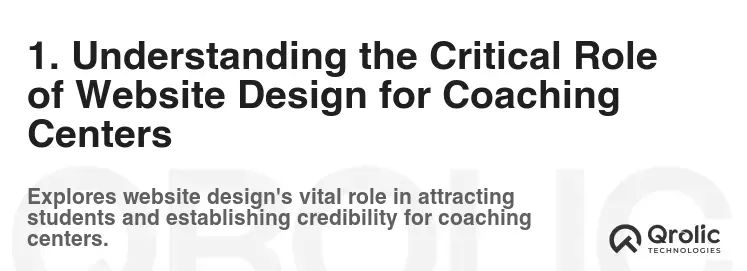
Why invest in exceptional website design? Because it directly impacts your bottom line. A poorly designed website can deter potential students, while a well-crafted one can significantly boost enrollment. Let’s break down the key reasons:
- First Impressions Matter: Your website is often the first interaction potential students and their parents have with your coaching center. A professional, visually appealing design instantly builds trust and credibility. Think of it as a digital handshake – you want it to be firm, warm, and memorable.
- Showcasing Expertise and Authority: A well-designed website allows you to effectively communicate your coaching center’s unique selling points, highlight your expert faculty, and showcase student success stories. It’s your platform to establish yourself as a leader in education.
- Lead Generation and Enrollment: A strategically designed website can capture leads through contact forms, online registration, and downloadable resources. It acts as a funnel, guiding potential students from initial interest to final enrollment.
- Improved Communication and Engagement: A website provides a centralized hub for all important information – course schedules, fees, faculty profiles, and contact details. This reduces administrative burden and enhances communication with students and parents.
- Competitive Advantage: In a crowded market, a standout website differentiates your coaching center from the competition. It allows you to showcase your unique approach, specialized programs, and commitment to student success.
- Mobile Optimization is Non-Negotiable: A significant portion of your target audience will access your website on mobile devices. Ensuring a seamless mobile experience is critical for engagement and conversion. A responsive design adapts to different screen sizes, providing optimal viewing on smartphones and tablets.
- Building a Strong Brand Identity: Your website is an extension of your brand. It should reflect your values, mission, and the unique experience you offer to students. Consistent branding across your website and other marketing materials creates a cohesive and memorable brand identity.
- Search Engine Optimization (SEO): A well-optimized website ranks higher in search engine results, making it easier for potential students to find you online. SEO involves optimizing your website’s content, structure, and technical aspects to improve its visibility in search engines like Google.
- Data-Driven Decision Making: Website analytics tools provide valuable insights into user behavior, allowing you to track website traffic, identify popular content, and understand how users interact with your website. This data can inform your marketing strategies and website improvements.
- Cost-Effective Marketing: Compared to traditional marketing methods, a website is a cost-effective way to reach a large audience and generate leads. It’s a long-term investment that can yield significant returns in terms of enrollment and revenue.
2. Key Elements of an Effective Coaching Center Website Design
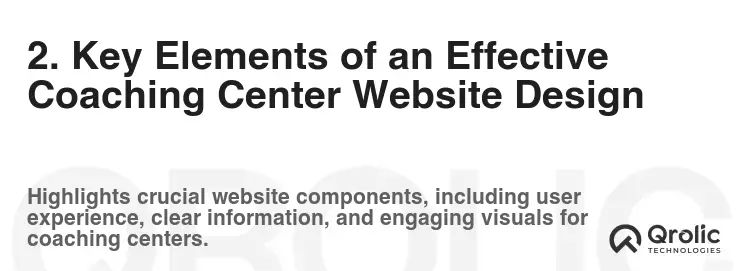
Creating a successful coaching center website requires careful planning and attention to detail. Here’s a breakdown of the essential elements:
2.1. Homepage Design: The First Impression
- Compelling Headline and Value Proposition: Immediately grab visitors’ attention with a clear and concise headline that highlights the benefits of your coaching center. What problems do you solve? What unique value do you offer?
- High-Quality Visuals: Use professional images and videos to showcase your coaching center, faculty, and student activities. Visuals should be relevant, engaging, and representative of your brand. Avoid generic stock photos and opt for authentic images that capture the essence of your coaching center.
- Clear Call-to-Actions (CTAs): Guide visitors towards desired actions with prominent CTAs, such as “Enroll Now,” “Request a Brochure,” or “Schedule a Consultation.” Place CTAs strategically throughout the homepage to encourage engagement.
- Easy Navigation: Ensure the homepage is easy to navigate, with clear menus and logical organization of content. Visitors should be able to quickly find the information they need.
- Social Proof: Display testimonials, reviews, and success stories to build trust and credibility. Real-life accounts from satisfied students and parents can be highly persuasive.
- Mobile-Responsive Design: As previously mentioned, ensure the homepage is fully responsive and optimized for mobile devices.
2.2. About Us Page: Building Trust and Credibility
- Tell Your Story: Share the story of your coaching center, its mission, and its values. Connect with visitors on an emotional level by highlighting your passion for education and your commitment to student success.
- Faculty Profiles: Showcase your expert faculty with detailed profiles that highlight their qualifications, experience, and areas of expertise. Include professional photos and brief biographies to personalize the faculty and build trust.
- Accreditations and Affiliations: Display any relevant accreditations, affiliations, or awards to demonstrate your coaching center’s credibility and commitment to quality.
- Contact Information: Provide clear and easily accessible contact information, including phone number, email address, and physical address.
2.3. Course Pages: Showcasing Your Offerings
- Detailed Course Descriptions: Provide comprehensive descriptions of each course, including the syllabus, learning objectives, target audience, and prerequisites.
- Course Schedule and Fees: Clearly display the course schedule, including dates, times, and locations. Also, provide transparent information about course fees and payment options.
- Faculty Assigned to Each Course: Clearly indicate which faculty members are teaching each course.
- Visual Aids: Use images and videos to enhance the course descriptions and showcase the learning environment.
- Online Registration: Integrate an online registration system to allow students to easily enroll in courses.
- SEO Optimization: Optimize each course page for relevant keywords to improve search engine rankings.
2.4. Blog: Sharing Knowledge and Expertise
- Regularly Updated Content: Maintain a blog with regularly updated content that is relevant to your target audience. Share insights, tips, and advice related to education, exam preparation, and career development.
- SEO Optimization: Optimize blog posts for relevant keywords to attract organic traffic from search engines.
- Engaging Content: Create engaging and informative content that captures the attention of your audience. Use visuals, videos, and interactive elements to enhance the reading experience.
- Call-to-Actions: Include call-to-actions in your blog posts to encourage visitors to learn more about your coaching center and enroll in your courses.
2.5. Contact Page: Making it Easy to Connect
- Contact Form: Include a contact form that allows visitors to easily submit inquiries.
- Phone Number and Email Address: Provide clear and easily accessible phone number and email address.
- Physical Address: Display your coaching center’s physical address and a map for easy navigation.
- Social Media Links: Include links to your social media profiles to encourage visitors to connect with you online.
2.6. Testimonials and Success Stories: Social Proof is Powerful
- Authentic Testimonials: Gather authentic testimonials from satisfied students and parents.
- Detailed Success Stories: Share detailed success stories that highlight the positive impact of your coaching center.
- Video Testimonials: Video testimonials are particularly impactful and can add a personal touch to your website.
- Placement: Strategically place testimonials and success stories throughout your website, especially on the homepage and course pages.
3. Optimizing Your Website for Search Engines (SEO)
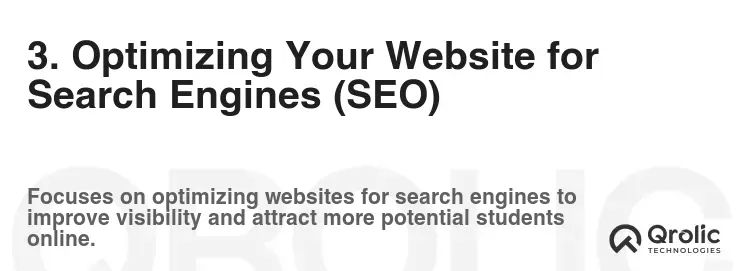
Search engine optimization (SEO) is crucial for driving organic traffic to your coaching center website. Here’s a breakdown of key SEO strategies:
3.1. Keyword Research: Finding the Right Words
- Identify Relevant Keywords: Conduct thorough keyword research to identify the keywords that potential students and parents are using to search for coaching centers online. Tools like Google Keyword Planner, Ahrefs, and SEMrush can help you identify relevant keywords with high search volume and low competition.
- Long-Tail Keywords: Focus on long-tail keywords, which are longer and more specific phrases that target a niche audience. For example, instead of targeting the keyword “coaching center,” target “best JEE coaching center in Delhi for class 12 students.”
- Local Keywords: Optimize your website for local keywords to attract students in your geographic area. Include your city and state in your keywords. For example, “math tutoring in [City, State].”
- Competitor Analysis: Analyze your competitors’ websites to identify the keywords they are targeting.
3.2. On-Page Optimization: Making Your Website Search-Engine Friendly
- Title Tags: Optimize your website’s title tags with relevant keywords. Title tags are the text that appears in search engine results pages (SERPs) and are a crucial ranking factor.
- Meta Descriptions: Write compelling meta descriptions that entice users to click on your website in search results. Meta descriptions should be concise, accurate, and include relevant keywords.
- Header Tags (H1-H6): Use header tags (H1-H6) to structure your content and highlight important keywords. The H1 tag should be used for the main heading of the page, and subsequent header tags should be used for subheadings.
- Content Optimization: Create high-quality, informative, and engaging content that is optimized for relevant keywords. Use keywords naturally throughout your content and avoid keyword stuffing.
- Image Optimization: Optimize your website’s images by using descriptive file names and alt tags that include relevant keywords.
- Internal Linking: Link to other relevant pages on your website to improve navigation and distribute link juice.
3.3. Off-Page Optimization: Building Your Website’s Authority
- Link Building: Build high-quality backlinks from other reputable websites to improve your website’s authority and ranking in search results.
- Local Citations: Create and maintain accurate local citations on online directories like Google My Business, Yelp, and Yellow Pages.
- Social Media Marketing: Promote your website and content on social media platforms to increase brand awareness and drive traffic to your website.
- Online Reputation Management: Monitor your online reputation and respond to reviews and comments in a timely and professional manner.
3.4. Technical SEO: Ensuring a Smooth User Experience
- Website Speed: Optimize your website’s speed to ensure a fast and seamless user experience. Use a content delivery network (CDN), optimize images, and minify code to improve website speed.
- Mobile-Friendliness: Ensure your website is fully responsive and optimized for mobile devices.
- Website Security (HTTPS): Secure your website with HTTPS to protect user data and improve search engine rankings.
- Sitemap: Create and submit a sitemap to search engines to help them crawl and index your website more efficiently.
- Robots.txt File: Use a robots.txt file to instruct search engines which pages on your website to crawl and index.
4. Website Design Best Practices for Coaching Centers
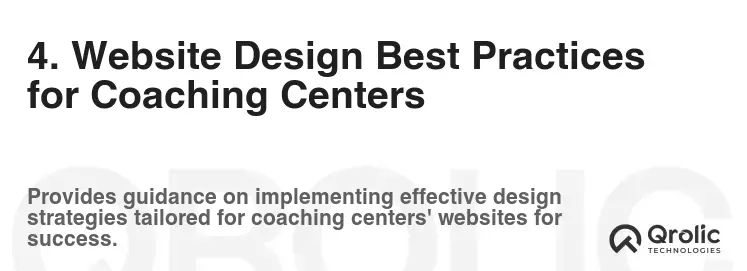
Beyond the core elements, consider these best practices to elevate your website:
- User-Friendly Navigation: Prioritize clear, intuitive navigation. Users should easily find what they’re looking for.
- Fast Loading Speed: Optimize images and code for fast loading times. Slow websites frustrate visitors and hurt SEO.
- High-Quality Content: Provide valuable, informative, and engaging content that addresses the needs of your target audience.
- Mobile-First Approach: Design with mobile users in mind. Ensure a seamless experience on smartphones and tablets.
- Accessibility: Make your website accessible to users with disabilities by following accessibility guidelines (WCAG).
- Regular Updates: Keep your website content fresh and up-to-date. Regularly update your blog, news section, and course information.
- Professional Photography: Use high-quality, professional photos of your coaching center, faculty, and students.
- Video Marketing: Incorporate videos into your website to engage visitors and showcase your coaching center.
- Analytics Tracking: Track your website’s performance using Google Analytics to monitor traffic, user behavior, and conversion rates.
- A/B Testing: Conduct A/B testing to optimize your website’s design and content for maximum conversion rates.
5. Qrolic Technologies: Your Partner in Education Website Design

At Qrolic Technologies (https://qrolic.com/), we understand the unique needs of coaching centers and the importance of a well-designed website. We specialize in tutoring web development and education website design, creating custom solutions that attract students, engage parents, and drive enrollment.
Our team of experienced designers and developers works closely with you to understand your brand, your target audience, and your business goals. We then create a website that is not only visually appealing but also strategically designed to achieve your objectives.
Here’s how Qrolic Technologies can help your coaching center:
- Custom Website Design: We create custom website designs that reflect your brand identity and appeal to your target audience.
- Responsive Design: We ensure your website is fully responsive and optimized for all devices, including smartphones, tablets, and desktops.
- SEO Optimization: We optimize your website for search engines to improve your visibility and attract organic traffic.
- Content Management System (CMS): We integrate a user-friendly CMS that allows you to easily manage and update your website content.
- Online Registration System: We implement an online registration system that allows students to easily enroll in your courses.
- Payment Gateway Integration: We integrate a secure payment gateway that allows you to accept online payments.
- Website Maintenance and Support: We provide ongoing website maintenance and support to ensure your website is always up-to-date and functioning properly.
- E-Learning Platform Development: We can develop complete e-learning platforms with features like course management, video hosting, assignments, and progress tracking.
- Learning Management System (LMS) Integration: We integrate with popular LMS platforms to streamline your online learning experience.
Why Choose Qrolic Technologies?
- Expertise in Education Website Design: We have a proven track record of creating successful websites for coaching centers and educational institutions.
- Custom Solutions: We tailor our solutions to meet your specific needs and goals.
- Experienced Team: Our team of designers, developers, and SEO specialists has years of experience in the industry.
- Affordable Pricing: We offer competitive pricing without compromising on quality.
- Excellent Customer Support: We provide excellent customer support and are always available to answer your questions.
6. Measuring Website Success: Key Performance Indicators (KPIs)
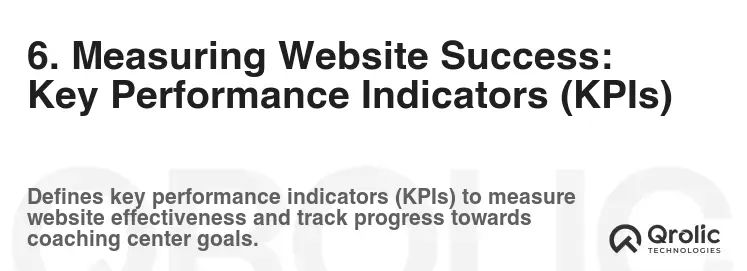
Once your website is launched, it’s important to track its performance and make adjustments as needed. Here are some key performance indicators (KPIs) to monitor:
- Website Traffic: Track the number of visitors to your website, including the sources of traffic (e.g., organic search, social media, referrals).
- Bounce Rate: Monitor the percentage of visitors who leave your website after viewing only one page. A high bounce rate may indicate that your website is not engaging or relevant to your target audience.
- Time on Page: Track the average amount of time visitors spend on each page of your website. Longer time on page indicates that visitors are engaged with your content.
- Conversion Rate: Measure the percentage of visitors who complete a desired action, such as enrolling in a course, requesting a brochure, or contacting you for more information.
- Lead Generation: Track the number of leads generated through your website, such as inquiries submitted through contact forms or registrations for online events.
- Enrollment Rate: Monitor the number of students who enroll in your courses as a direct result of visiting your website.
- Cost Per Acquisition (CPA): Calculate the cost of acquiring a new student through your website.
- Return on Investment (ROI): Measure the return on investment for your website design and marketing efforts.
By tracking these KPIs, you can identify areas for improvement and optimize your website to achieve your business goals.
7. Future Trends in Coaching Center Website Design
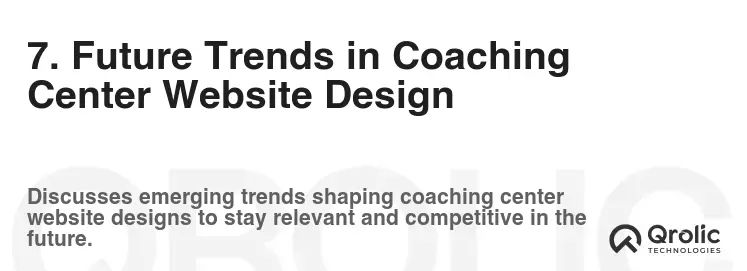
The digital landscape is constantly evolving, so it’s important to stay up-to-date on the latest trends in website design. Here are some future trends to watch out for:
- Personalization: Websites will become increasingly personalized, tailoring content and experiences to individual users based on their interests, behavior, and demographics.
- Artificial Intelligence (AI): AI will be used to enhance website functionality, such as chatbots that provide instant customer support and recommendation engines that suggest relevant courses.
- Virtual Reality (VR) and Augmented Reality (AR): VR and AR will be used to create immersive learning experiences and virtual tours of your coaching center.
- Voice Search Optimization: Websites will need to be optimized for voice search to cater to users who are using voice assistants like Siri and Google Assistant.
- Data Privacy and Security: Data privacy and security will become increasingly important, and websites will need to comply with regulations like GDPR and CCPA.
- Interactive Content: Interactive content, such as quizzes, polls, and calculators, will become more popular as a way to engage visitors and generate leads.
- Micro-Interactions: Micro-interactions, such as subtle animations and feedback, will be used to enhance the user experience and make websites more engaging.
- Accessibility First: Focus on making websites more accessible to people with disabilities, going beyond minimum standards to provide truly inclusive experiences.
By embracing these future trends, you can ensure that your coaching center website remains competitive and effective in the years to come.
8. Conclusion: Investing in Your Digital Future
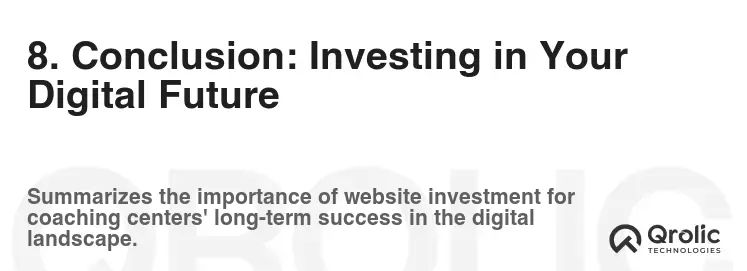
A well-designed website is an indispensable asset for any coaching center seeking to thrive in today’s competitive educational landscape. By prioritizing user experience, SEO optimization, and a clear articulation of your unique value proposition, you can transform your website into a powerful tool for attracting students, building trust, and driving enrollment. Remember to leverage the expertise of professionals like Qrolic Technologies to create a website that truly reflects your brand and achieves your business goals. Embrace the digital future and watch your coaching center flourish.
